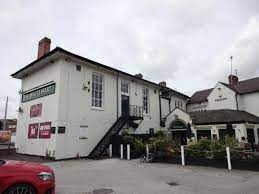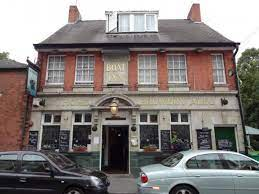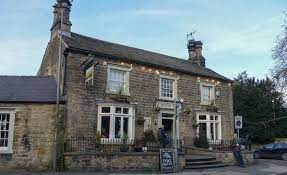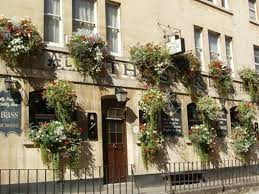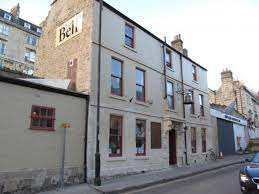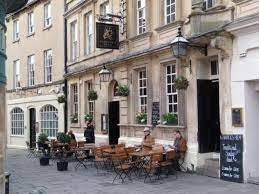Festive greetings one and all! Can I just begin by pointing out that the perceived spelling mistake in this blog's title is deliberate, for reasons that will soon become clear. Hopefully this will prevent any fellow grammar Nazis from getting on my case about it. Last week, on a chilly, December afternoon I made my first foray into Leicestershire on behalf of this blog. My intention was to investigate the pubs in the village of Castle Donington, an area I first became accustomed to due to my regular commute when I worked at East Midlands Airport. I wasn't sure what to expect but, as you're about to find out, it was a worthwhile afternoon.
Castle Donington is a village and civil parish in the North West Leicestershire, part of the Derby postcode area and on the edge of the National Forest. It is the closest town to East Midlands Airport.
Castle Donington stands on the former Nottingham to Birmingham trunk road. The town is a mix of the old and new, with modern shops mixed with dignified Georgian and Regency houses. Several timber framed houses dating from the 17th century and earlier survive along the main road.
The town has no rail station, but East Midlands Parkway opened early in 2008 at Ratcliffe-on-Soar providing links on the Midland Main Line.
In 1868 the Midland Railway opened the Castle Donington Line, which included Castle Donington and Shardlow railway station, on the northern edge of the town. The station was closed to regular passenger traffic in 1930, and closed completely and demolished in 1968. The access driveway still exists but for pedestrians only, and is the start of a footpath to Hemington, running past the site of the old goods yard, now a scrap yard. The railway remains open for some freight traffic.
King's Mill, the nearby crossing on the River Trent, is mentioned in a charter issued by Æthelred the Unready in 1009 regarding the boundaries of Weston-on-Trent. Dunintune or Dunitone is mentioned twice in the Domesday Book of 1086 as having land belonging to Countess Ælfgifu and land assigned to Earl Hugh. It is called Castoldonyngtoin in a duchy of Lancaster warrant of 1484.
Castle Donington has two primary schools, St Edwards and Orchard Primary School, each serving roughly one half of the town. A high school — Castle Donington College, which celebrated its 50th anniversary on 10 September 2007 — takes students from ages 10–14 and then moving on to either Hind Leys Community College or Ashby, as there is no high school in Castle Donington.
East Midlands Airport is served by several major airlines including BMI, whose headquarters are nearby, Ryanair, Jet2.Com, Thomson Airways (who have a training centre at the airport) and many others. DHL also has a base at the airport. Castle Donington is also home to the Donington Park motor racing circuit.
BMI (British Midland), an airline, is headquartered in Donington Hall, Castle Donington. The airline moved its headquarters to Donington Hall in 1982. Excalibur Airways had its head office on the grounds of East Midlands Airport in Castle Donington, as did Orion Airways.
Once a year on May bank holiday Monday a medieval market is held on the main shopping street in Castle Donington. This event comprises local stalls selling various kinds of produce and goods accompanied by dancing and music.
Usually during the last week of October each year the town hosts a travelling fair called Donington Wakes.
On the second Saturday of every month a farmers market is held on the playground of St Edward's C of E primary school.
A very large market known as Donington Sunday Market takes place virtually every Sunday at Donington Park.
Donington Park was the original venue for the Monsters of Rock festivals through the 1980s and 1990s, and is now the home of the annual Download Festival. It also hosted a Formula One Grand Prix – The European Grand Prix – in April 1993, which was won by Ayrton Senna. It was also set to be the home of the British Grand Prix from 2010 for at least 10 years, but the agreement was cancelled due to financial problems. The circuit also hosts the Donington Grand Prix Collection, the world's largest collection of Formula One and Grand Prix vehicles. Brian Henton, an F1 driver, was born in Castle Donington.
The village is easily accessible by public transport and by car as it sits near a slip road connecting it to the M1 at Junction 24. This area itself was the scene of a terrifying ghostly encounter in October 2009. A motorist driving here at around 7.45am was shaken by the sight of a man in a green jacket, dark trousers and headwear standing in the middle lane of the motorway. The driver looked away briefly to check her rear view mirror in an attempt to see if she could safely brake and upon returning her gaze to the road, was shocked to see the figure had vanished.
Whilst Castle Donington may not be as big or as well known as previous blog locations, I was certainly intrigued by what it had to offer. Initially however, things did not quite go according to plan. Having braved 2 buses to reach the village from home, I intended to start my journey at the top of the central hill along which the village is built. Handily, the first and last pubs in the village are at opposite ends of this incline and so I sensibly decided to begin at the top and work my way down. The pub at the top of the hill, The Nags Head, was my planned first destination but this quickly hit a snag when I arrived to find that it was closed and all the lights were off. Further research quickly revealed that there are a number of pubs in the village that are closed in the middle part of the day, presumably to save money during quieter periods. Peeved, but not to be deterred, I decided to reverse my itinerary and trudged down to the bottom of the hill to begin my investigations at the pub that was originally scheduled to be my last for the day. Anxious to get underway, and having found my bearings, I kicked things off at The Lamb Inn.
Owned and run by Marston's, The Lamb is a small, pleasant building with a cream exterior and an interior tastefully decorated in shades of red and cream. A TV, dartboard, fruit machine and jukebox are present, as are 3 older gentlemen playing cards, the day's only other patrons. There is lots of seating throughout with access to both sides of the central bar from doors on either side of the main entrance. The bar is square, with service available on both sides. 4 handpulls occupy the bar, 2 on each side, featuring Marston's Pedigree and Burton Bitter, Jennings Cocker Hoop and Ringwood XXXX Porter. I opted for a pint of the Pedigree, poured by a burly, but very pleasant bar man. I took a seat by a nearby window, looking out into the room, watching Moto GP highlights on the TV opposite. I admit to being a bit wary when I first entered due to the lack of customers but everyone seemed very pleasant and were happy to keep themselves to themselves. As I took in the surroundings, including the car park and smoking area to the rear, I took a deep sip of the Pedigree, which was very well kept, as you would expect from a premises run by its parent chain. The Lamb Inn has the feel of a friendly community pub, serving regulars from the village but happy to accommodate visitors. I took my time with this particular pint as I refreshed my plan of action. Once the glass was finally empty, I took my leave and moved on.
Further up the street, on the opposite side of the road, was my next destination, The Tudor Hotel.
This family run hotel and restaurant boasts a traditional interior with mock Tudor décor. The ground floor is divided into a restaurant (closed during my visit) and a bar, with the hotel reception located between the two. The restaurant is open between 12-2 and 6-9pm so at the time of my arrival, is not currently serving food. The bar area is a fairly large, open space with lots of seating, a games machine and a fruit machine as well as a TV and a jukebox. The bar is small but well stocked and includes 2 handpulls, on which Doom Bar and Pedigree are normally available however the Doom Bar was off on this occasion. Happy to settle for another pint of Pedigree, I took a seat on one of the stools at the bar whilst my pint was poured by the receptionist who also doubles as bar staff. I was the only customer in the bar at the time of my visit but this didn't put me off too much and I bided my time by getting trounced on the nearby games machine. However, I would have my revenge later. The Pedigree here was also very well looked after and tasty so I was finding little to complain about in Castle Donington so far. Following another defeat at the hands of my electronic opponent and the last drops of my pint going down smoothly, I once again set off. The next phase of my journey involved moving off of the main road and up a neighbouring hill which leads towards the village centre proper. This particular route is considerably steeper than the main path so it is just as well that my next location is situated halfway up.
Billed as a friendly, street corner pub, the next premises on my list is The Jolly Potters.
This is a small, traditional boozer with old décor and the requisite Toby jugs hanging from the ceiling throughout. The main room is small and roughly rectangular with a snug to one side and breweriana placed around the interior. Old books and framed flower cuttings are also in evidence and there is a real fire near to the bar, which is slightly off centre from the main doorway. A few locals are around when I enter and they exchange polite hellos as I peruse the bar. The 4 handpulls are all in use and offering Bass, Pedigree, Doom Bar and Fuller's London Pride. After a brief moment of indecision, I decided on London Pride as I haven't tried it for a while and still have fond memories of my brief spell at Fuller's. I perched myself in the corner snug where I was briefly befriended by two whippets belonging to a local. I always like dog friendly pubs as they tend to be a bit more relaxed, although they do make me wish I had a canine companion of my own. This pub has a very welcoming, homely feel to it and is my favourite place at this stage in the day, helped by the condition of the London Pride which lives up to its name.
As reluctant as I was to pull myself away from the Jolly Potters, I was extremely excited about the place I was going to visit next, even though I had only recently been made aware of its existence. Further up the hill lies the central shopping precinct for Castle Donington and approximately halfway down this street sits a premises that has only been open since April. Introducing Castle Donington's very own micropub, The Chequered Flag.
Named after the device that signals the end of a motor race in honour of the nearby Donington Park circuit, The Chequered Flag is motor racing themed and features racing memorabilia displayed throughout. The original owners have recently sold the business to a local man named Bert and they still pop in regularly to oversee things, as they do during my visit. The day of my visit is the day on which Bert has officially taken over. The main entrance is slightly elevated above the street level and the beer is visible through a small window behind the cash register. The beer is served direct from the casks which are kept in a temperature controlled room to ensure quality. The pub features 4 ales, one of which, Shardlow Reverend Eaton's is always available. The 3 guests on offer during my visit are Burton Bridge Stairway to Heaven and XL Bitter and Scribblers Hoppy Potter and the Goblet of Ale. 7 real ciders are also available, along with a small range of wines. The welcome I am given here is a good one, very friendly and polite and also curious as my identity. This gives way to respect when I make it clear that I have come all the way from Nottingham to try the beer. I started off with the Reverend Eaton's (4.5%), named after a man who was rector of Shardlow for 40 years. This is a smooth, premium bitter, bronze in colour with a hop forward taste and a malty base. It is certainly very well kept. During my time soaking up the atmosphere, I engaged in conversation with the other patrons, all locals and learn a bit more about the area and village as a whole. As I've experienced throughout the day, everyone is very welcoming. I decided that it would be almost rude not to have a second pint here so I went for a pint of Stairway to Heaven (5.0%), pale, smooth and hoppy, brewed with Fuggles and Goldings hops. I immensely enjoyed my time here and it was with a hint of regret that I finished my pint and my way out into the winter evening, with the intention of visiting one more venue before catching the bus home. This meant making my way back down the hill towards the main road. With the evening now fully upon me, I happened to catch a glimpse of the parish church of St. Edward King and Martyr which is located just uphill from the precinct and also has a ghost story associated with it. As the story goes, a brother and sister visiting the church in 1950 to lay flowers spoke at length to a vicar who told them that he had once been based at the church but had left in 1906. Once they returned home and related their tale, they were informed that the vicar had in fact passed away in that year. A suitably creepy tale for this time of year I think!
Having decided to write off The Nags Head due to reasons of distance, the last place on my list for the day was The Cross Keys.
This is a low slung building with a mock Tudor interior and a wide array of seating throughout, to both sides of the main entrance. The seating is a mix of booths and comfy chairs. The bar is U shaped and includes 5 handpulls, 2 of which are not in use. The 3 remaining offer Pedigree, Doom Bar and Bath Ales Gem. Being a fan of Bath Ales, there was no way that I wasn't going to opt for Gem, which was exactly as it should be -- well-kept and delicious. As I enjoyed my pint, I noticed a games machine opposite me and, seeking revenge for earlier, I succeeded in winning £14 from it. Take that machines!
With the last dregs of my pint remaining and the night noticeably colder, I reflected upon the day's events whilst I whiled away the minutes before my bus was due. Castle Donington is by and large a very pleasant place with friendly people and welcoming pubs. Whilst the quantity of ales available is not as wide as elsewhere, the quality is very good indeed! At no point was I left wanting for an improvement in taste and general refreshment from any of the pints I consumed. The range of pubs in the village is varied and interesting in their different approaches to cask ales. Whereas The Lamb and The Cross Keys will do very well with locals and those passing through, The Chequered Flag will certainly gain in popularity through word of mouth both from those in the village and further afield. With micropubs a growing commodity in these times, The Chequered Flag is a welcome addition to the fold and I have no doubt it is in safe hands. If there's one pub you have to visit in Castle Donington, make sure it's this one! If my recommendation is enough to get people down there visiting the pub, and the village in general, then it will only benefit the village, its people, economy and the wider ale community as a whole. Villages like this can offer a lot.
So that's all for this time. I'm hoping to squeeze another trip in between now and New Year but, in the event that time and money prohibit this, I wish you all a very Merry Christmas and best wishes for 2015!
So that's all for this time. I'm hoping to squeeze another trip in between now and New Year but, in the event that time and money prohibit this, I wish you all a very Merry Christmas and best wishes for 2015!






